758th Airlift Squadron
| 758th Airlift Squadron | |
|---|---|
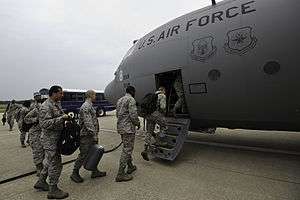 Airmen of the 910th Airlift Wing board a C-130 Hercules of the 758th Airlift Squadron to participate in Exercise Global Medic | |
| Active | 1943–1945; 1947–1949; 1957–present |
| Country |
|
| Branch |
|
| Role | Airlift |
| Part of | Air Force Reserve Command |
| Garrison/HQ | Pittsburgh International Airport |
| Engagements |
Mediterranean Theater of Operations European Theater of Operations |
| Decorations |
Distinguished Unit Citation Air Force Outstanding Unit Award Republic of Vietnam Gallantry Cross with Palm |
| Insignia | |
| 758th Airlift Squadron emblem (approved 1 October 1990)[1] |
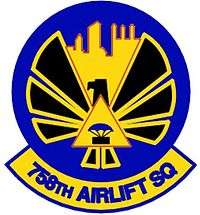 |
| 758th Troop Carrier Squadron emblem (approved 20 August 1960)[2] |
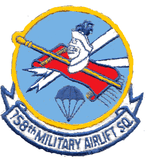 |
| Patch with 758th Bombardment Squadron emblem[3] |
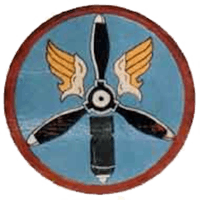 |
The 758th Airlift Squadron is part of the 911th Airlift Wing at Pittsburgh International Airport, Pennsylvania. It operates the C-130H2 version of the Lockheed C-130 Hercules aircraft, providing global tactical airlfit.
Mission
To organize, recruit, and train Air Force reserve personnel to provide airlift of airborne forces, their equipment and supplies, and delivery of these forces and materials by airdrop, landing, or cargo extraction systems.
History
World War II
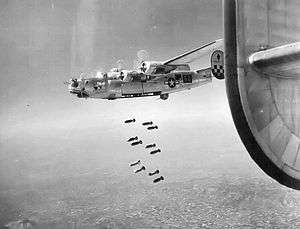
The squadron was first activated as the 758th Bombardment Squadron at Alamogordo Army Air Field, New Mexico on 1 July 1943 as one of the original squadrons of the 459th Bombardment Group. It was equipped with Consolidated B-24 Liberator heavy bombers and trained at Davis-Monthan Field, Arizona.[1][4] The squadron received deployment orders for the Mediterranean Theater of Operations in September 1943, but was diverted to fly long-range convoy escort missions over the Newfoundland Banks to Long Island Sound, November–December 1943 while its station in Italy was being constructed.
The squadron deployed to Southern Italy in January 1944 and entered combat in March as part of Fifteenth Air Force's strategic bombing campaign. The squadron attacked enemy military, industrial and transportation targets in Italy, France, Germany, Poland, Czechoslovakia, Austria, Hungary, Romania, Bulgaria, Greece and Yugoslavia, bombing railroad marshalling yards, oil refineries, airfields, concentration centers and other strategic objectives. The squadron earned a Distinguished Unit Citation when the 459th Group led the 304th Bombardment Wing on a raid against an aircraft plant at Bad Voslau. The group pressed its attack despite opposition by enemy interceptors and intense flak.[4]
The squadron was occasionally diverted from the strategic bombing campairng to carry out support and interdiction operations. It struck railroads during March 1944 to support Operation Shingle, the landings at Anzio. It struck bridges, harbors, and troop concentrations in August 1944 in the preinvasion phase of Operation Dragoon, th invasion of southern France. It also hit communications lines and other targets during March and April 1945 to support the advance of British Eighth Army and American Fifth Army in northern Italy.[4]
Following VE Day, the squadron returned to the United States in August 1945.[1] The squadron was programmed for deployment to the Pacific Theater of Operations as a Boeing B-29 Superfortress very heavy bombardment squadron and reassembled at Sioux Falls Army Air Field, South Dakota at the end of August. However, Japan surrendered shortly after the squadron's arrival and in was inactivated on 28 August 1945.[1]
Reserve training
The squadron was reactivated as a reserve unit at Long Beach Army Air Field, California in July 1947. Although nominally a very heavy bomber squadron, it operated a variety of trainer aircraft to maintain proficiency under Air Defense Command's 416th AAF Base Unit (later the 2347th Air Force Reserve Training Center).[5][6] President Truman’s reduced 1949 defense budget required reductions in the number of units in the Air Force,[7] In addition, Continental Air Command, which had assumed responsibility for reserve training in 1948, reorganized its reserve units under the wing base organization system in 1949. This resulted in the squadron's parent 459th Group being reduced to a single operational squadron, and the 758th was inactivated on 27 June 1949.[1][4]
Reactivation as a reserve airlift unit

During the first half of 1955, the Air Force began detaching Air Force reserve squadrons from their parent wing locations to separate sites. Communities were more likely to accept the smaller squadrons than the large wings and the location of separate squadrons in smaller population centers would facilitate recruiting and manning.s[8] The 459th Wing, located at Andrews Air Force Base, Maryland activated the 758th, now the 758th Troop Carrier Squadron, in 1957 as its third flying squadron at Greater Pittsburgh Airport, Pennsylvania. In April 1959, the wing reorganized under the Dual Deputy system. Its 459th Troop Carrier Group was inactivated[9] and the 756th, 757th and 758th Troop Carrier Squadrons were assigned directly to the wing.[1][10]
Activation of groups under the wing
Although the dispersal of flying units was not a problem when the entire wing was called to active service, mobilizing a single flying squadron and elements to support it proved difficult. This weakness was demonstrated in the partial mobilization of reserve units during the Berlin Crisis of 1961 To resolve this, at the start of 1962, Continental Air Command determined to reorganize its reserve wings by establishing groups with support elements for each of its troop carrier squadrons. This reorganization would facilitate mobilization of elements of wings in various combinations when needed. However, as this plan was entering its implementation phase, another partial mobilization occurred for the Cuban Missile Crisis. The formation of troop carrier groups was delayed until January for wings that had not been mobilized.[11] The squadron was assigned to the new 911th Troop Carrier Group on 17 January.[1][10]
Lineage
- Constituted as the 758th Bombardment Squadron (Heavy) on 19 May 1943
- Activated on 1 July 1943
- Redesignated 758th Bombardment Squadron, Heavy c. Sep 1944
- Inactivated on 28 August 1945
- Redesignated 758th Bombardment Squadron, Very Heavy on 13 May 1947
- Activated in the reserve on 12 July 1947
- Inactivated on 27 June 1949
- Redesignated 758th Troop Carrier Squadron, Medium on 24 October 1957
- Activated in the reserve on 16 November 1957
- Redesignated 758th Military Airlift Squadron on 1 January 1967
- Redesignated 758th Tactical Airlift Squadron on 1 March 1972
- Redesignated 758th Airlift Squadron on 1 February 1992[1]
Assignments
- 459th Bombardment Group, 1 July 1943 – 28 August 1945
- 459th Troop Carrier Group, 12 July 1947 – 27 June 1949
- 459th Troop Carrier Group, 16 November 1957
- 459th Troop Carrier Wing, 14 April 1959
- 911th Troop Carrier Group (later 911th Military Airlift Group, 911th Tactical Airlift Group, 911th Airlift Group), 17 January 1963
- 911th Operations Group, 1 August 1992 – present[1]
Stations
|
|
Aircraft
- Consolidated B-24 Liberator (1943–1945)
- North American T-6 Texan (1947–1949)
- Beechcraft T-7 Navigator (1947–1949)
- Beechcraft T-11 Kansan (1947–1949)
- Fairchild C-119 Flying Boxcar (1957–1967)
- Douglas C-124 Globemaster II (1966–1972)
- Fairchild C-123 Provider (1972–1980)
- Lockheed C-130 Hercules (1980 – 2018)[1]
- Boeing C-17 Globemaster III (beginning in 2019)
|}
Awards and campaigns
| Award streamer | Award | Dates | Notes |
|---|---|---|---|
| Distinguished Unit Citation | 23 April 1944 Bad Voslau, Austria | 758th Bombardment Squadron[1] | |
| Air Force Outstanding Unit Award | 1 January 1977-31 December 1978 | 757th Tactical Airlift Squadron[1] | |
| Air Force Outstanding Unit Award | 1 August 1987-31 July 1989 | 757th Airlift Squadron[1] | |
| Air Force Outstanding Unit Award | 15 September 1990-14 September 1992 | 757th Airlift Squadron[1] | |
| Republic of Vietnam Gallantry Cross with Palm | 1 January 1968-29 February 1972 | 757th Tactical Airlift Squadron[1] |
| Campaign Streamer | Campaign | Dates | Notes |
|---|---|---|---|
| Air Offensive, Europe | 12 February 1944–5 June 1944 | 758th Bombardment Squadron[1] | |
| Air Combat, EAME Theater | 12 February 1944–11 May 1945 | 758th Bombardment Squadron[1] | |
| Rome-Arno | 12 February 1944–9 September 1944 | 758th Bombardment Squadron[1] | |
| Central Europe | 22 March 1944–21 May 1945 | 758th Bombardment Squadron[1] | |
| Normandy | 6 June 1944–24 July 1944 | 758th Bombardment Squadron[1] | |
| Northern France | 25 July 1944–14 September 1944 | 758th Bombardment Squadron[1] | |
| Southern France | 15 August 1944–14 September 1944 | 758th Bombardment Squadron[1] | |
| North Apennines | 10 September 1944–4 April 1945 | 758th Bombardment Squadron[1] | |
| Rhineland | 15 September 1944–21 March 1945 | 758th Bombardment Squadron[1] | |
| Po Valley | 3 April 1945–8 May 1945 | 758th Bombardment Squadron[1] |
References
Notes
- 1 2 3 4 5 6 7 8 9 10 11 12 13 14 15 16 17 18 19 20 21 22 23 24 25 Endicott, Judy D. (April 7, 2008). "Factsheet 758 Airlift Squadron (AFRC)". Air Force Historical Research Agency. Retrieved June 21, 2018.
- ↑ Maurer, Combat Squadrons, p. 740
- ↑ Watkins, p. 104
- 1 2 3 4 Maurer, Combat Units, pp. 334-335
- 1 2 "Abstract, History Long Beach Air Force Field, Jul-Dec 1947". Air Force History Index. Retrieved June 22, 2018.
- ↑ "Abstract, History 2347 AF Reserve Training Center, Jul-Dec 1948". Air Force History Index. Retrieved June 22, 2018.
- ↑ Knaack, p. 25
- ↑ Cantwell, p. 156
- ↑ Robertson, Patsy (August 9, 2017). "Factsheet 459 Operations Group (AFRC)". Air Force Historical Research Agency. Retrieved June 22, 2018.
- 1 2 "Fact Sheet 459th Air Refueling Wing". 459th Air Refueling Wing Public Affairs. August 20, 2012. Retrieved August 2, 2016.
- ↑ Cantwell, pp. 189-191
- ↑ "Abstract, History Long Beach Airport, Jan-Jun 1948". Air Force History Index. Retrieved June 22, 2018.
- ↑ Station information in Dollman, except as noted.
Bibliography
![]()
- Cantwell, Gerald T. (1997). Citizen Airmen: a History of the Air Force Reserve, 1946-1994 (PDF). Washington, D.C.: Air Force History and Museums Program. ISBN 0-16049-269-6. Retrieved December 17, 2016.
- Knaack, Marcelle Size (1978). Encyclopedia of US Air Force Aircraft and Missile Systems (PDF). Vol. 2, Post-World War II Bombers 1945-1973. Washington, DC: Office of Air Force History. ISBN 0-912799-59-5. Retrieved December 17, 2016.
- Maurer, Maurer, ed. (1983) [1961]. Air Force Combat Units of World War II (PDF) (reprint ed.). Washington, DC: Office of Air Force History. ISBN 0-912799-02-1. LCCN 61060979. Retrieved December 17, 2016.
- Maurer, Maurer, ed. (1982) [1969]. Combat Squadrons of the Air Force, World War II (PDF) (reprint ed.). Washington, DC: Office of Air Force History. ISBN 0-405-12194-6. LCCN 70605402. OCLC 72556. Retrieved December 17, 2016.
- Ravenstein, Charles A. (1984). Air Force Combat Wings, Lineage & Honors Histories 1947-1977 (PDF). Washington, DC: Office of Air Force History. ISBN 0-912799-12-9. Retrieved December 17, 2016.
- Watkins, Robert A. (2009). Insignia and Aircraft Markings of the U.S. Army Air Force In World War II. Volume IV, European-African-Middle Eastern Theater of Operations. Atglen,PA: Shiffer Publishing, Ltd. ISBN 978-0-7643-3401-6.
